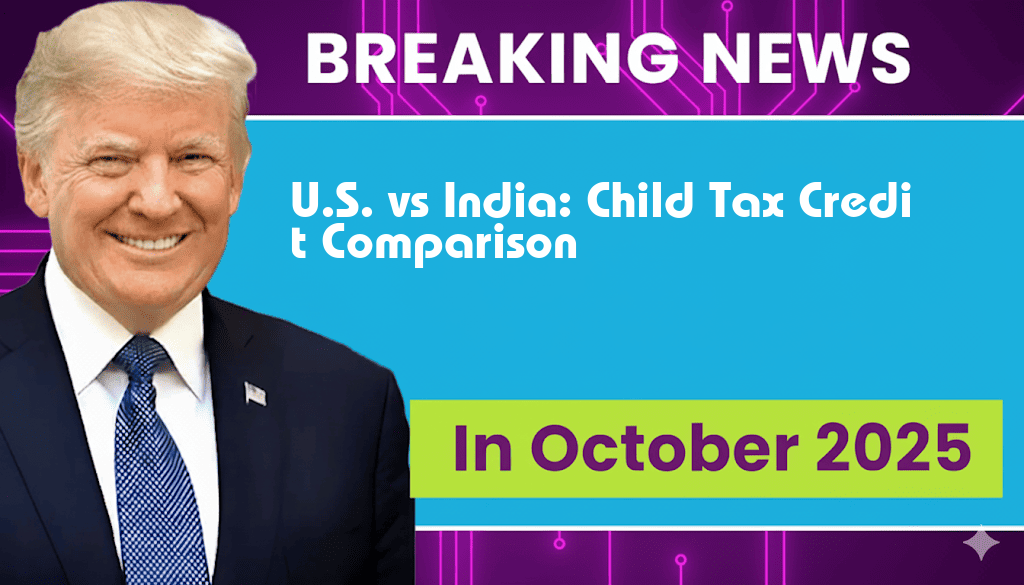Global Comparison: $2,200 Child Tax Credit in the U.S. vs ₹1,65,000 Benefits in India
The financial support provided to families with children varies significantly across the globe, with notable differences between the United States and India. In the U.S., the Child Tax Credit (CTC) offers up to $2,200 per qualifying child, designed to alleviate the costs of raising children. Meanwhile, in India, the government’s initiatives aiming to support families include benefits that total approximately ₹1,65,000 per child through various schemes, including direct cash transfers and allowances for education and healthcare. This article explores the frameworks of these two systems, their impact on families, and how they reflect each country’s socio-economic landscape.
Understanding the Child Tax Credit in the U.S.
The Child Tax Credit in the United States has undergone significant changes in recent years, particularly during the pandemic. Initially established in 1997, the credit was expanded under the American Rescue Plan Act in 2021, temporarily increasing the maximum amount available to families. The credit is partially refundable, meaning families can receive a refund even if they owe no federal taxes. Here are key aspects of the CTC:
- Maximum Credit: Families can receive up to $2,200 per qualifying child under the age of 17.
- Eligibility: Available to families with annual incomes below certain thresholds, which vary based on filing status.
- Refundability: The refundable portion allows families to receive money back even if they have no tax liability.
Child Support Benefits in India
Conversely, India’s approach to supporting families with children is characterized by a range of welfare schemes that collectively provide substantial financial assistance. The ₹1,65,000 figure represents various benefits, including direct cash transfers, educational allowances, and health care support. The Indian government has focused on improving the overall welfare of children through initiatives such as:
- Direct Benefit Transfer (DBT): A cash transfer program aimed at providing financial support to low-income families.
- Midday Meal Scheme: Provision of free meals to children in schools, aimed at improving nutrition and encouraging school attendance.
- Beti Bachao Beti Padhao: A campaign to promote the education and empowerment of girls, including financial incentives for families.
Comparing Impact on Families
The differing structures of support in the U.S. and India reflect their unique socio-economic contexts. In the U.S., the CTC is primarily aimed at middle-class families, providing a direct financial boost that can be used for various child-related expenses. In contrast, India’s multi-faceted approach addresses not just financial aid but also health and education, recognizing the need for comprehensive support.
| Feature | United States | India |
|---|---|---|
| Maximum Benefit | $2,200 per child | ₹1,65,000 (approx.) per child |
| Type of Support | Tax credit, partially refundable | Direct cash transfers, educational and nutritional support |
| Primary Target Group | Middle-class families | Low to middle-income families |
Future Outlook
As policymakers in both countries continue to debate and refine child support systems, the effectiveness of these programs will be closely monitored. In the U.S., discussions around the permanence of the expanded Child Tax Credit continue, while in India, the government seeks to enhance the reach and efficiency of its welfare programs. The effectiveness of these initiatives will ultimately depend on their ability to adapt to changing economic conditions and the needs of families.
For further reading on the Child Tax Credit, visit Wikipedia. To learn more about India’s welfare schemes, check out this article on Forbes.
Frequently Asked Questions
What is the purpose of the Child Tax Credit in the U.S.?
The Child Tax Credit in the U.S. aims to provide financial support to families raising children, helping to alleviate the costs of child-rearing and improve overall family financial stability.
How does the amount of the Child Tax Credit in the U.S. compare to benefits in India?
The U.S. offers a Child Tax Credit of $2,200, while families in India receive benefits amounting to ₹1,65,000. This comparison highlights significant differences in financial support for families across these two nations.
Are there eligibility requirements for the Child Tax Credit in the U.S.?
Yes, eligibility for the Child Tax Credit in the U.S. is based on income levels, the number of qualifying children, and filing status. Families must meet certain criteria to receive the full benefit.
What types of benefits are included in India’s ₹1,65,000 support?
In India, the ₹1,65,000 benefits may encompass various forms of support, including direct cash transfers, educational benefits, and healthcare assistance, aimed at improving the welfare of children and families.
How do these child benefits impact families in both countries?
The Child Tax Credit in the U.S. and the benefits in India play crucial roles in reducing poverty and enhancing the quality of life for families. These financial aids can lead to better access to education, healthcare, and overall child development.
